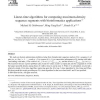Free Online Productivity Tools
i2Speak
i2Symbol
i2OCR
iTex2Img
iWeb2Print
iWeb2Shot
i2Type
iPdf2Split
iPdf2Merge
i2Bopomofo
i2Arabic
i2Style
i2Image
i2PDF
iLatex2Rtf
Sci2ools
CORR
2002
Springer
2002
Springer
Linear-Time Algorithms for Computing Maximum-Density Sequence Segments with Bioinformatics Applications
an abstract optimization problem arising from biomolecular sequence analysis. For a sequence A of pairs (ai, wi) for i = 1, . . . , n and wi > 0, a segment A(i, j) is a consecutive subsequence of A starting with index i and ending with index j. The width of A(i, j) is w(i, j) = i k j wk, and the density is ( i k j ak)/w(i, j). The maximum-density segment problem takes A and two values L and U as input and asks for a segment of A with the largest possible density among those of width at least L and at most U. When U is unbounded, we provide a relatively simple, O(n)-time algorithm, improving upon the O(n log L)-time algorithm by Lin, Jiang and Chao. We then extend this result, providing an O(n)-time algorithm for the case when both L and U are specified.
Abstract Optimization Problem | Biomolecular Sequence Analysis | Consecutive Subsequence | CORR 2002 | Education |
| Added | 18 Dec 2010 |
| Updated | 18 Dec 2010 |
| Type | Journal |
| Year | 2002 |
| Where | CORR |
| Authors | Michael H. Goldwasser, Ming-Yang Kao, Hsueh-I Lu |
Comments (0)

